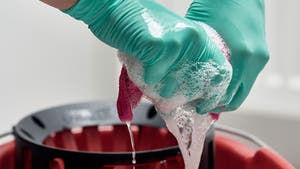COVID-19 has suddenly and dramatically shifted infection prevention efforts in places from the home to public spaces, workplaces and businesses large and small. Many of these new behaviors are things that should have been common practice in pre-pandemic times. The efforts have been shown to be hugely beneficial not only in the fight against COVID-19, but also against other respiratory viruses, like influenza, which is at a record low this year.
Now as we look towards wide-spread vaccinations and re-openings, the question is what infection prevention strategies need to remain post-pandemic, and when COVID-19 cases become less common, what new behaviors will we keep?
Wearing Masks
Masks are now an integrated part of our lives – expected across our daily activities – whether you’re running errands, waiting in line, dropping off the kids – don’t forget your mask. A public health intervention has never been so prevalent across the majority of the U.S.
Staying power?
We may move away from behaviors and protocols around masking, but there are fundamental infection prevention behaviors that should stay.
Disinfecting Surfaces
One of the earliest measures was cleaning and disinfection. With any new pathogen, especially a respiratory one where we know fomites (i.e. objects or materials which are likely to carry infection) can play a role, routine cleaning and disinfection is pivotal. Early on we saw consumers wiping down everything that entered their home and spaces they interacted with, including groceries, mail, handles, desks, and packages.
Staying power?
While cleaning and disinfecting have a place, we learned that SARS-CoV-2, the virus that causes COVID-19, is not predominantly transmitted by infected surfaces or objects, unlike other common respiratory pathogens like respiratory syncytial virus (RSV) or influenza. It can and does spread this way, but not as frequently as through respiratory inhalation.
It is important that we continue to practice routine cleaning and disinfection and emphasize that it is one part of a holistic infection prevention strategy. COVID-19 after all, is not the only infectious disease we live with and cleaning and disinfection should be a standard part of our lives.
We can expect to see business take a proactive role in maintaining these efforts by implementing a variety of new disinfection practices, such as leveraging electrostatic technology like the Clorox® Total 360® ProPack Electrostatic Sprayer to disinfect airport terminals or hospitals, handing out hand sanitizers or disinfecting wipes to passengers when they board aircraft or customers when they enter a store, or having restaurant personnel slow the seating process to allow time for all surfaces to be cleaned and disinfected between guests.
Avoiding the Indoors
As we continue to learn more from transmission data, it is now known that clustered outbreaks can occur when people interact together indoors even with masks. This has put an unprecedented spotlight on the health of our indoor environments. There is now enormous emphasis on indoor protocols, including social distancing and air ventilation. These are not new areas of study for epidemiologists, but because of COVID-19, social distancing and air ventilation in public spaces have become priorities in infection prevention among consumers.
Staying Power?
Staying away from indoor situations may not be practical for many in their everyday lives, and may not be broadly beneficial for public health, education or small business impact. Like masking, protocols for reduced capacity in indoor settings like restaurants will gradually fade.
Instead we’ll see continual investments in infection prevention efforts like hand hygiene, routine cleaning and disinfecting protocols and staying home when sick. From plexiglass partitions to marked indicators for physical distancing, we’ve seen a lot of emphasis on infection prevention during this pandemic.
Awareness Around Infections
Our awareness of infectious disease and the importance of general infection prevention including hand hygiene and routine cleaning and disinfection.
Early on, the focus was on staying home, masking or staying six feet apart. It was quickly realized that wasn’t enough. COVID-19 prevention requires multiple intervention strategies. Increasing emphasis on all the infection prevention behaviors – masking, physical distancing, hand hygiene, cleaning and disinfection, and avoiding indoor spaces with those outside your household – is what prevents the spread of COVID-19. No single layer of prevention is perfect, but together, they can significantly reduce risk. We know that now.
Staying power?
Using a holistic approach to reducing infectious diseases, whether they be COVID-19 or any other, is one that has definite staying power. While the protocols may change, the holistic nature of infection control will remain the same. Infection prevention efforts are front and center now, not only for infection preventionists like me, but to each and every one of us. We have a real opportunity to change how we treat infections in our everyday life even beyond COVID-19.
For the latest information on COVID-19 and variants, visit our CloroxPro COVID-19 Hub.
Dr. Saskia v. Popescu is a paid consultant for Clorox Healthcare.


